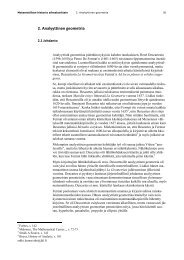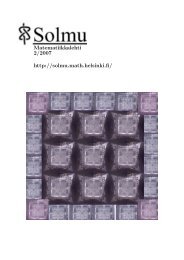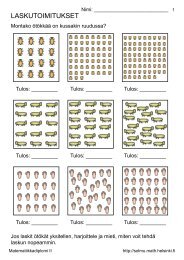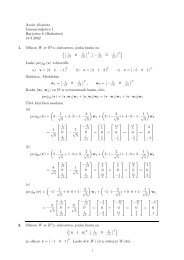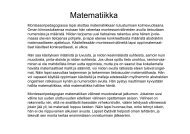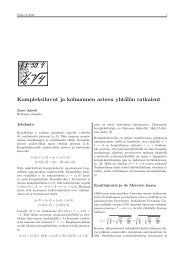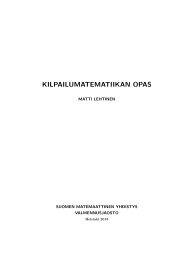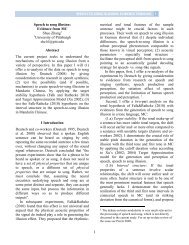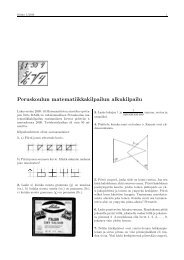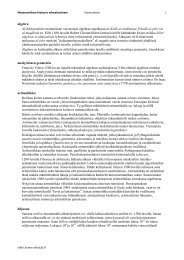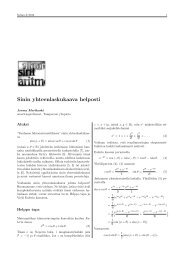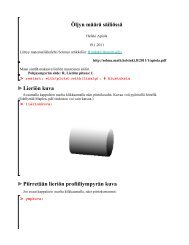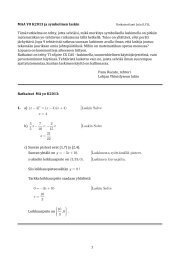ARBITRAGE WITH FRACTIONAL BROWNIAN MOTION?1 - Helsinki.fi
ARBITRAGE WITH FRACTIONAL BROWNIAN MOTION?1 - Helsinki.fi
ARBITRAGE WITH FRACTIONAL BROWNIAN MOTION?1 - Helsinki.fi
Create successful ePaper yourself
Turn your PDF publications into a flip-book with our unique Google optimized e-Paper software.
6 CHRISTIAN BENDER, TOMMI SOTTINEN, AND ESKO VALKEILA<br />
V T (ϕ m ) = g m (ST H − s 0 ) ≈ (ST H − s 0 ) + for large m. Hence, these arbitrages<br />
constitute, for large m, approximate hedges for an at-the money European<br />
call option with initial capital 0.<br />
We close this section by a remark summarizing some interesting results<br />
on existence and absence of arbitrage for different classes of portfolios.<br />
Remark. (i) Cheridito proves in [8] that the fractional Black-Scholes model<br />
is free of arbitrage with the class A ɛ,si of ɛ-simple strategies for every ɛ > 0.<br />
On the other hand, the cheapest super-replicating portfolio for a European<br />
call option in the class A ɛ,si is to buy one share of the stock at time 0 and<br />
to hold it until time T . Hence, only a trivial price bound for European call<br />
options can be obtained that way.<br />
(ii) A portfolio is called almost simple, if there is a sequence of nondecreasing<br />
stopping times (τ k ) k∈N such that P (τ k = T in<strong>fi</strong>nitely often) = 1 and<br />
the portfolio is constant on (τ k , τ k+1 ]. This means that the number of rearranging<br />
times is <strong>fi</strong>nite on almost every path, but not necessarily bounded<br />
as function on Ω. Existence of a self-<strong>fi</strong>nancing almost simple arbitrage has<br />
been shown by Rogers [20], making use of the history of a fractional Brownian<br />
motion starting at −∞, and subsequently by Cheridito [8], taking only<br />
the history starting from 0 into account. Both constructions rely on the<br />
long memory property of the fractional Brownian motion.<br />
(iii) A very intuitive construction of an arbitrage in fractional Cox-Ross-<br />
Rubinstein models, exploiting the memory of a binary version of a fractional<br />
Brownian motion, can be found in [24] and [4]. In [24] the discrete<br />
approximation of the fractional Black-Scholes model is based on ordinary<br />
products, in [4] on discrete Wick products.<br />
(iv) Under proportional transaction costs, absence of arbitrage for the fractional<br />
Black-Scholes models is proved in [14]. The introduction of proportional<br />
transaction costs requires, however, that only processes of bounded<br />
variation can be considered as portfolios.<br />
We conclude that there seems to be no subclass of self-<strong>fi</strong>nancing strategies<br />
that is suf<strong>fi</strong>ciently small to be free of arbitrage and, at the same time,<br />
suf<strong>fi</strong>ciently rich to induce a sensible price for European call options by hedging<br />
arguments.<br />
4. ‘Wick self-<strong>fi</strong>nancing portfolios’<br />
It has been <strong>fi</strong>rst suspected by Hu and Øksendal [15], that the existence of<br />
arbitrage in the fractional Black-Scholes model is – mathematically – due to<br />
the non-zero expectation property of the forward integral w.r.t. fractional<br />
Brownian motion. They suggested to build a <strong>fi</strong>nancial calculus for fractional<br />
Brownian models on the Wick-Itô integrals instead, an approach which was<br />
later extended by Elliott and van der Hoek [12]. The Wick-Itô integral<br />
is based on a renormalization operator, called the Wick product. Given



